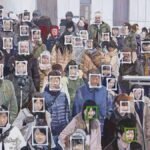
Creating Art: Authenticity and Ownership in the Visual Arts by Fabian Ajogwu and Jess Castellote,
Creating Art: Authenticity and Ownership in the Visual Arts by Fabian Ajogwu, a Professor of corporate Governance at Lagos Business School and Jess Castellote, who has a doctorate degree in art history is an incisive examination of two foundational pillars in the art world: authenticity and ownership.

The book dives into these complex, evolving concepts and the significant roles they play in the visual arts, by offering a thorough analysis that combines legal, economic, and practical perspectives. Through a mix of case studies and simplified explanations, Ajogwu and Castellote present a balanced view that is invaluable to artists, collectors, curators, and art enthusiasts alike. The book’s broad appeal lies in its ability to address essential questions about creative ownership, intellectual property, and authenticity.

Ajogwu and Castellote break down the three key elements of copyright law – authorship, innovation, and economics—to help readers understand how these principles shape the life cycle of artworks. Authorship, they argue, is only the beginning. Authenticity encompasses the artist’s intent, cultural context, and even the preservation and restoration process, making it a dynamic concept far beyond mere attribution. The concept of ownership encompasses infringement, reproduction, appropriation, collaborative works, as well as the contracts and agreements necessary to maintain these rights.
One important aspect of Creating Art is its breakdown of the financial implications of copyright for artists. Copyright law, as the authors demonstrate, is not just about protecting intellectual property—it’s about securing an artist’s financial future. Ajogwu and Castellote highlight how copyright laws can empower artists to maintain control over their creations, particularly in a market that often values brand names and commodified art over originality. For emerging artists, these rights can open doors to revenue streams, allowing them to monetize their work through licensing, royalties, and even resale royalties in some cases. The book’s explanation of moral rights—rights to attribution, the right to object to derogatory treatment, and the protection against distortions of the work—enlightens readers on how these legal structures exist to safeguard both the artist’s vision and their earning potential.

Ajogwu and Castellote further illustrate the book’s insights with detailed case studies, grounding their arguments in real-world examples that art professionals will recognize. From instances of navigating copyright laws in other countries of the world to instances of intellectual property rights being contested in court and connecting laws to court cases.
Each case study in the book sheds light on the delicate balance artists must strike between creative expression and legal protection. These cases serve as a practical guide, demonstrating the market dynamics that influence artistic production and the complex negotiations that occur when protecting art. Notably, the authors avoid bogging readers down with technical jargon, providing explainers that simplify each term and associated concepts. The authors also clarify how certain aspects of copyright law differ for artworks, including the unique provisions like moral rights that apply to the visual arts but not necessarily to computer-generated works.
The book offers a roadmap for artists navigating issues of copyright and intellectual property, stressing the importance of knowledge as a tool for self-advocacy. Emerging artists, who may otherwise struggle to navigate complex copyright systems, will find a wealth of advice on using legal frameworks to protect their interests while building a brand that resonates with authenticity.
Ajogwu and Castellote’s balanced approach to depth and accessibility makes this book a vital resource. Legal professionals, artists, art collectors, and scholars will appreciate the detailed analyses and clear breakdown of case law, while art enthusiasts will gain insights into the philosophical and practical dimensions of authenticity and ownership. As an examination of the power dynamics between creators, collectors, and institutions, Creating Art stands as a timely and thought-provoking contribution to ongoing discussions in the art world, especially around the role of technology in reshaping art markets and protecting creative expression.
In a world where questions about the commercialisation of art and the ethical boundaries of creative ownership are more pressing than ever, Creating Art: Authenticity and Ownership in the Visual Arts is a must-read. For artists, curators, collectors, and scholars, this book offers both an accessible introduction to and an in-depth study of art ownership’s legal and economic nuances. With its relevance to current discussions in the art world, Creating Art is readily available through various platforms, including Amazon and select local bookstores, such as Jazzhole, Quintessence and Ouida, making it accessible for those interested in exploring these important themes further. Ajogwu and Castellote have crafted a work that bridges academic rigour with practical insights, creating a resource that is as useful for professional development and personal enrichment.










